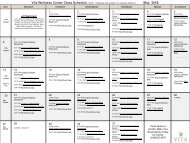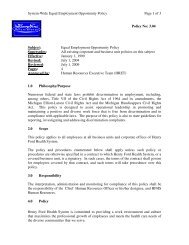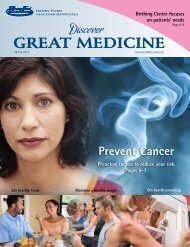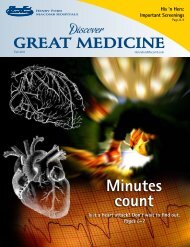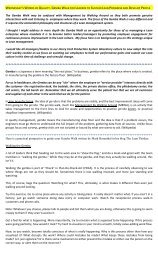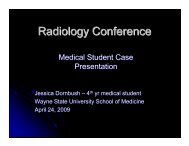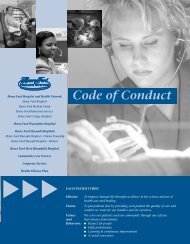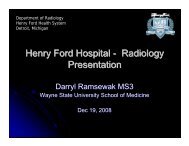Anticoagulation-related intracranial hemorrhage - Henry Ford Health ...
Anticoagulation-related intracranial hemorrhage - Henry Ford Health ...
Anticoagulation-related intracranial hemorrhage - Henry Ford Health ...
Create successful ePaper yourself
Turn your PDF publications into a flip-book with our unique Google optimized e-Paper software.
<strong>Anticoagulation</strong> <strong>related</strong><br />
Intracranial <strong>hemorrhage</strong><br />
Tamer Abdelhak, MD<br />
Senior Staff NeuroCritical Care<br />
Program Director NeuroCritical Care Fellowship<br />
Departments Of Neurology and Neurosurgery<br />
<strong>Henry</strong> <strong>Ford</strong> <strong>Health</strong> System<br />
5/9/2012 1
Disclosure<br />
None<br />
5/9/2012 2
Objectives<br />
Clotting pathways refresher.<br />
<strong>Anticoagulation</strong> Associated ICH<br />
Epidemiology, i Mortality.<br />
AC reversal guidelines n Protocols<br />
New Agents.<br />
5/9/2012 3
5/9/2012 4
5/9/2012 5
5/9/2012 6
5/9/2012 7<br />
Hoffman 2003, 2005, J Thromb Thrombolysis
Every bleeding eventually stops<br />
but how?<br />
Activation of Platelets leading to<br />
Platelet clot.<br />
Activation of clotting cascade leading<br />
to Fibrin clot formation.<br />
5/9/2012 8
5/9/2012 9
Clotting factors<br />
1- Natural deficiency:<br />
Hemophiliacs, liver disease.<br />
2-Acquired:<br />
Drugs e.g warfarin, heparin…etc<br />
5/9/2012 10
5/9/2012 11
5/9/2012 12
5/9/2012 13
5/9/2012 14
So is anticoagulation a problem for<br />
us???<br />
5/9/2012 15
5/9/2012 16
Bleeding<br />
mechanical heart valves (1–8.3%),<br />
atrial fibrillation (0–6.6%),<br />
coronary heart disease (0–19 19.3%),<br />
venous thromboembolism (0–16.7%),<br />
ischemic cerebrovascular disease (2–13%)<br />
The most frequent complication of OAC is<br />
gastrointestinal bleeding,<br />
<strong>intracranial</strong> <strong>hemorrhage</strong> (ICH) is the main<br />
cause of fatal bleeding.<br />
5/9/2012 17
Epidemiology<br />
1-1 1.7% of the population is currently<br />
receiving OAC with vitamin K<br />
antagonists. (Schurgers, Blood 2004)<br />
5–12% of ICH is <strong>related</strong> to OAC.<br />
(Flaherty&Broderick Neurology 2007)<br />
Rate of OAC-ICH is about 2–9 per<br />
100,000 /y, an incidence 7- to 10-<br />
fold higher than in the untreated<br />
population(Steiner et al Stroke 2006)<br />
5/9/2012 18
Epidemiology<br />
The incidence of anticoagulant-associated<br />
associated<br />
intracerebral <strong>hemorrhage</strong> quintupled in<br />
our population during the 1990s.<br />
The majority of this change can be<br />
explained by increasing warfarin use.<br />
Anticoagulant-associated associated intracerebral<br />
<strong>hemorrhage</strong> now occurs at a frequency<br />
comparable to subarachnoid <strong>hemorrhage</strong>.<br />
h<br />
(Flaherty&Broderick Neurology 2007)<br />
5/9/2012 19
Annual incidence rates for intracerebral <strong>hemorrhage</strong> (ICH),<br />
anticoagulant‐associated intracerebral <strong>hemorrhage</strong> (AAICH), and<br />
ischemic stroke in the Greater Cincinnati/Northern Kentucky area<br />
The increasing incidence of anticoagulant‐associated<br />
intracerebral <strong>hemorrhage</strong>.<br />
Flaherty, M; Kissela, B; Woo, D; Kleindorfer, D; Alwell, K;<br />
Sekar, P; Moomaw, C; Haverbusch, M; Broderick, J<br />
Neurology. 68(2):116‐121, January 9, 2007.<br />
5/9/2012 20<br />
2
Flood is coming<br />
5/9/2012 21
5/9/2012 22
5/9/2012 23
Why is OAC ICH increasing<br />
problem??<br />
larger number of elderly patients<br />
that receive OAC for cardiovascular<br />
reasons.<br />
The increased use of combined<br />
anticoagulant regimens<br />
The addition of antiplatelets<br />
the expanded use of OAC for<br />
secondary stroke prevention.<br />
Smith et Al 1999 Arch IM<br />
5/9/2012 24
5/9/2012 25
5/9/2012 26
Is outcome any different between<br />
AA ICH and non AA ICH???<br />
5/9/2012 27
Answer<br />
Patients with OAT-<strong>related</strong> ICH have a<br />
mortality rate approaching 60%,<br />
compared to about 40% for their<br />
non-anticoagulated counterparts<br />
( Hart Stroke 1995, Lavoie J Trauma<br />
2004, Mina J Trauma 2003)<br />
5/9/2012 28
New Data<br />
299 ICHs. Use of warfarin was<br />
associated with a higher mortality<br />
from ICH (OR, 1.62; 95% CI, 0.88<br />
88-<br />
2.98). INRs >3 increased the odds of<br />
dying of ICH by 2.66 66-fold (95% CI,<br />
1.21-5.86). (Fang(<br />
et al Stroke 2012)<br />
5/9/2012 29
New data<br />
Re LY trial 2.0 years of follow-up (18,113 pts)<br />
154 <strong>intracranial</strong> i <strong>hemorrhage</strong>s h occurred in 153 participants<br />
i<br />
46% intracerebral (49% mortality),<br />
45% subdural (24% mortality), and<br />
8% subarachnoid (31% mortality).<br />
The rates of <strong>intracranial</strong> <strong>hemorrhage</strong> were 0.76%, 0.31%,<br />
per year among those assigned to warfarin, dabigatran 150<br />
mg respectively (P
Reversal is indicated<br />
HOW????<br />
5/9/2012 31
5/9/2012 32
AHA 2010<br />
1. Patients with a severe coagulation factor deficiency or severe<br />
thrombocytopenia should receive appropriate factor replacement<br />
therapy or platelets, respectively (Class I; Level of Evidence: C).<br />
(New recommendation)<br />
2. Patients with ICH whose INR is elevated due to OACs should<br />
have their warfarin withheld, receive therapy to replace vitamin<br />
i<br />
K–dependent factors and correct the INR, and receive intravenous<br />
vitamin K (Class I; Level of Evidence: C).<br />
PCCs have not shown improved outcome compared with FFP but<br />
may have fewer complications compared with FFP and are<br />
reasonable to consider as an alternative to FFP (Class IIa; Level of<br />
Evidence: B).<br />
rFVIIa does not replace all clotting factors, and although h the INR<br />
may be lowered, clotting may not be restored in vivo; therefore,<br />
rFVIIa is not routinely recommended as a sole agent for OAC<br />
reversal in ICH (Class III; Level of Evidence: C). (Revised from the<br />
previous guideline).<br />
5/9/2012 33
AHA 2010<br />
3. Although rFVIIa can limit the extent of<br />
hematoma expansion in noncoagulopathic<br />
ICH patients, there is an increase in<br />
thromboembolic risk with rFVIIa and no<br />
clear clinical benefit in unselected patients.<br />
Thus rFVIIa is not recommended in<br />
unselected patients. (Class III; Level of<br />
Evidence: A). (New recommendation)<br />
Further research to determine whether any<br />
selected group of patients may benefit from<br />
this therapy is needed before any<br />
recommendation for its use can be made.<br />
5/9/2012 34
Vitamin K<br />
slowly reverts INR to its normal values,<br />
needing 2–24 h to be effective.<br />
All patients with OAC-ICH must be given<br />
vitamin K. Otherwise, INR will not be<br />
corrected completely and a rebound<br />
coagulopathy might develop<br />
should be administered IV as the effect is<br />
too slow using the oral route.<br />
( Dentali et al J Thrombosis Hemostasis 2006)<br />
5/9/2012 35
Fresh Frozen Plasma<br />
IV at a dose of 10-15 mL/kg<br />
requires the concomitant<br />
administration of vitamin K.<br />
Delays due to thawing and<br />
preparation.<br />
volume overload has to be<br />
considered in older patients<br />
small risk of viral<br />
transmission,thrombocytopenia,<br />
anaphylactoid reactions,septicemia<br />
(Goldstein Stroke 2006)<br />
5/9/2012 36
Prothrombin Concentrate Complex<br />
PCC<br />
Is a mixture of clotting factors II,<br />
VII, IX, X, and protein C and S,<br />
derived from large donor plasma<br />
pools by ion-exchange<br />
chromatography and<br />
cryoprecipitation<br />
(Bershad & Suarez NCC 2009)<br />
5/9/2012 37
PCC<br />
Bebulin (US) 3 F<br />
Profilnine (US)3 F<br />
Proplex-Ta<br />
Preconativ<br />
Beriplex P/N<br />
Kaskadil<br />
Octaplex<br />
Cofact<br />
PPSB-HT Nichiyaku<br />
Konyne<br />
Prothrombinex-HT<br />
5/9/2012 38
Comparison<br />
Blood type matching<br />
Thawing time<br />
PCC<br />
No<br />
No<br />
FFP<br />
Yes<br />
Yes<br />
Infection risk Y Y<br />
Thrombosis risk Y Y<br />
Clotting factor<br />
concentration<br />
High<br />
Low<br />
Infusion volume<br />
EBM for use of PCC<br />
Sandler SG, Rath CE, Ruder A. Prothrombin complex concentrates Yasaka M, Oomura M, Ikeno K, Naritomi H, Minematsu K.<br />
in acquired hypoprothrombinemia. Ann Intern Med.<br />
Effect of prothrombin complex concentrate on INR and blood<br />
1973;79(4):485–91.<br />
coagulation system in emergency patients treated with warfarin<br />
Josic D, Hoffer L, Buchacher A, Schwinn H, Frenzel W, Biesert L,<br />
overdose. Ann Hematol. 2003;82(2):121–3.<br />
et al. Manufacturing of a prothrombin complex concentrate aiming<br />
van Aart L, Eijkhout HW, Kamphuis JS, Dam M, Schattenkerk<br />
at low thrombogenicity. Thromb Res. 2000;100(5):433–41.<br />
ME, Schouten TJ, et al. Individualized dosing regimen for<br />
Hellstern P. Production and composition of prothrombin complex<br />
prothrombin<br />
concentrates: correlation between composition and therapeutic<br />
complex concentrate more effective than standard<br />
efficiency. Thromb Res. 1999;95(4 Suppl 1):S7–12.<br />
treatment in the reversal of oral anticoagulant therapy: an open,<br />
McQuillan AM, Eikelboom JW, Hankey GJ, Baker R, Thom J,<br />
Staton J, et al. Protein Z in ischemic stroke and its etiologic<br />
subtypes. Stroke. 2003;34(10):2415–9.<br />
Lubetsky A, Hoffman R, Zimlichman R, Eldor A, Zvi J, Kostenko<br />
V, et al. Efficacy and safety of a prothrombin complex<br />
concentrate (Octaplex) for rapid reversal of oral anticoagulation.<br />
Thromb Res. 2004;113(6):371–8.<br />
Evans G, Luddington R, Baglin T. Beriplex P/N reverses severe<br />
warfarin-induced overanticoagulation immediately and completely<br />
in patients presenting with major bleeding. Br J Haematol.<br />
2001;115(4):998–1001.<br />
Ostermann H, Haertel S, Knaub S, Kalina U, Jung K, Pabinger I.<br />
Pharmacokinetics of Beriplex P/N prothrombin complex concentrate<br />
in healthy volunteers. Thromb Haemost. 2007;98(4):<br />
790–7.<br />
Boulis NM, Bobek MP, Schmaier A, Hoff JT. Use of factor IX<br />
complex in warfarin-<strong>related</strong> <strong>intracranial</strong> <strong>hemorrhage</strong>. Neurosurgery.<br />
1999;45(5):1113–8. discussion 1118–1119.<br />
Cartmill M, Dolan G, Byrne JL, Byrne PO. Prothrombin complex<br />
concentrate for oral anticoagulant reversal in neurosurgical<br />
emergencies. Br J Neurosurg. 2000;14(5):458–61.<br />
Fredriksson K, Norrving B, Stromblad LG. Emergency reversal<br />
of anticoagulation after intracerebral <strong>hemorrhage</strong>. Stroke. 1992;<br />
23(7):972–7.<br />
Lankiewicz MW, Hays J, Friedman KD, Tinkoff G, Blatt PM.<br />
Urgent reversal of warfarin with prothrombin complex concentrate.<br />
J Thromb Haemost. 2006;4(5):967–70.<br />
Pabinger I, Brenner B, Kalina U, Knaub S, Nagy A, Ostermann<br />
H. Prothrombin complex concentrate (Beriplex P/N) for<br />
emergency anticoagulation reversal: a prospective multinational<br />
clinical trial. J Thromb Haemost. 2008;6(4):622–31.<br />
Preston FE, Laidlaw ST, Sampson B, Kitchen S. Rapid reversal<br />
of oral anticoagulation with warfarin by a prothrombin complex<br />
concentrate (Beriplex): efficacy and safety in 42 patients. Br J<br />
Haematol. 2002;116(3):619–24.<br />
Vigue B, Ract C, Tremey B, Engrand N, Leblanc PE, Decaux A,<br />
prospective randomized d controlled trial. Thromb Res. 2006;<br />
118(3):313–20.<br />
Bruce D, Nokes TJ. Prothrombin complex concentrate (Beriplex<br />
P/N) in severe bleeding: experience in a large tertiary hospital.<br />
Crit Care. 2008;12(4):R105.<br />
Yasaka M, Sakata T, Naritomi H, Minematsu K. Optimal dose of<br />
prothrombin complex concentrate for acute reversal of oral<br />
anticoagulation. Thromb Res. 2005;115(6):455–9.<br />
Hellstern P, Halbmayer WM, Kohler M, Seitz R, Muller-Berghaus<br />
G. Prothrombin complex concentrates: indications, contraindications,<br />
and risks: a task force summary. Thromb Res. 1999;95(4<br />
Suppl 1):S3–6.<br />
Schulman S, Bijsterveld NR. Anticoagulants and their reversal.<br />
Transfus Med Rev. 2007;21(1):37–48.<br />
50. Pindur G, Morsdorf S. The use of prothrombin complex<br />
concentrates<br />
in the treatment of <strong>hemorrhage</strong>s induced by oral<br />
anticoagulation. Thromb Res. 1999;95(4 Suppl 1):S57–61.<br />
Makris M, Watson HG. The management of coumarin-induced<br />
over-anticoagulation Annotation. Br J Haematol. 2001;114(2):<br />
271–80.<br />
Crawford JH, Augustson BM. Prothrombinex use for the reversal<br />
of warfarin: is fresh frozen plasma needed? Med J Aust. 2006;<br />
184(7):365–6.<br />
Holland L, Warkentin TE, Refaai M, Crowther MA, Johnston<br />
MA, Sarode R. Suboptimal effect of a three-factor prothrombin<br />
complex concentrate (Profilnine-SD) in correcting supratherapeutic<br />
international normalized ratio due to warfarin overdose.<br />
Transfusion. 2009;49(6):1171–7.<br />
Blatt PM, Lundblad RL, Kingdon HS, McLean G, Roberts HR.<br />
Thrombogenic materials in prothrombin complex concentrates.<br />
Ann Intern Med. 1974;81(6):766–70.<br />
5/9/2012 40<br />
et al. Ultra-rapid management of oral anticoagulant therapy<strong>related</strong><br />
surgical <strong>intracranial</strong> <strong>hemorrhage</strong>. Intensive Care Med.<br />
2007;33(4):721–5.<br />
55. Schimpf K, Zeltsch C, Zeltsch P. Myocardial infarction<br />
complicating<br />
activated prothrombin complex concentrate substitution in<br />
patient with hemophilia A. Lancet. 1982;2(8306):1043.<br />
Hampton KK, Preston FE, Lowe GD, Walker ID, Sampson B.<br />
Reduced coagulation activation following infusion of a highly<br />
purified factor IX concentrate compared to a prothrombin complex<br />
concentrate. Br J Haematol. 1993;84(2):279–84.<br />
57. Aledort LM. Factor IX and thrombosis. Scand J Haematol Suppl.
EBM<br />
Prothrombin Complex Concentrates<br />
for Oral Anticoagulant Therapy-<br />
Related Intracranial Hemorrhage: A<br />
Review of the Literature<br />
Bershad & Suarez, NCC, 2010<br />
5/9/2012 41
INCH Trial<br />
INR Normalization in Coumarin<br />
associated intracerebral<br />
Haemorrhage<br />
Steiner Thorsten<br />
University Hospitals: Halle,<br />
Mannheim, Erlangen, München,<br />
Heidelberg, Germany<br />
Randomized, open label, parallel<br />
groups, multicenter.<br />
5/9/2012 42
INCH inclusion<br />
Spontaneous intracerebral and<br />
subdural hematoma diagnosed by CT<br />
within 12 hours after onset of<br />
symptoms<br />
•Patient receiving oral<br />
anticoagulation w INR ≥ 2<br />
•Age ≥ 18 years<br />
5/9/2012 43
INCH outcome<br />
1ry: INR
Factor VII<br />
Still in use in many places<br />
Single factor replacement.<br />
Activated<br />
t Falling out of favor for expense and<br />
side effects after FAST Trial (Mayer et al<br />
2005 NEJM).<br />
5/9/2012 45
Protocols<br />
How can we be practical?<br />
We have an ICH in ER and high<br />
INR!!!!!<br />
Tell me what should I do now???<br />
5/9/2012 46
5/9/2012 47
AAFP<br />
5/9/2012 48
October 4-7, 2012<br />
Sheraton Denver<br />
Downtown Hotel | Denver, Colorado, USA<br />
5/9/2012 49<br />
49
5/9/2012 50<br />
50
HFHS <strong>Anticoagulation</strong> Reversal<br />
Protocol<br />
These guidelines are supported by<br />
latest literature from AHA, ACCP and<br />
published articles and expert<br />
consultation.<br />
Let me share our background data<br />
5/9/2012 51
2000-20102010 HFH NCCU<br />
CoRICH Trial<br />
2971 pts with <strong>intracranial</strong> bleeds.<br />
122 were identified on warfarin (4.1%).<br />
Mean admission GCS was 10 (3-15),<br />
mean pre-therapy INR 4.20 (1.65-18.78) 18.78) and<br />
mean INR post therapy 1.25 (0.95-1.82). Mean<br />
time elapsed before a post therapy repeat INR<br />
check was 155 minutes (7-1090 min).<br />
Reversal agents used included: vitamin K in 36<br />
patients (87.8%), FFP in 34 patients (82.9%),<br />
activated factor 7 in 19 patients (46.3%) and<br />
prothrombin concentrate complex in 20 patients<br />
(48.7%).<br />
5/9/2012 52
CoRICH data<br />
When looking at outcomes of these<br />
patients, average ICU length of stay was<br />
12.5 days,<br />
There was a 39% mortality.<br />
Thromboembolic events were<br />
encountered in 4 patients (10%).<br />
<strong>Anticoagulation</strong> was resumed in 12<br />
patients. The mean return to<br />
anticoagulation 15.6 days (range 2-58<br />
days)<br />
(Abdelhak et al 2012 SCCM)<br />
5/9/2012 53
HFHS Warfarin reversal protocol<br />
INR 1.7-3:<br />
for ICH 2011/2012<br />
Profilnine 20 u/kg+Factor VII 10<br />
mcg/kg.<br />
INR >3:<br />
Profilnine 20 u/kg+Factor VII 20<br />
mcg/kg.<br />
5/9/2012 54
Follow up<br />
INR 15-30 minutes after<br />
administration of reversal then q 4<br />
hours.<br />
If first INR unsatisfactory may give<br />
FFP.<br />
5/9/2012 55
Heparin et al<br />
Protamine sulphate.<br />
1 mg for each 100 units heparin IV.<br />
1 mg for each 1 mg enoxparin 8h.<br />
5/9/2012 56
Direct X inhibitors<br />
Dabigatran (2009, BI, Pradaxa)<br />
Rivaroxaban (2011, Janssen&Bayer<br />
, Xarelto)<br />
Apixaban (Not FDA approved yet,<br />
Pfizer&BM, Eliquis)<br />
i 5/9/2012 57
5/9/2012 58
5/9/2012 59
5/9/2012 60
The new arrivals<br />
Direct thrombin inhibitor.<br />
Oral once or twice daily.<br />
Safer and more expensive than<br />
warfarin.<br />
No need for INR monitoring<br />
Renal excreted.<br />
Reversal : Help us GOD.<br />
5/9/2012 61
A, Effect of rivaroxaban followed by prothrombin complex concentrate (PCC) or placebo on<br />
the prothrombin time (PT; mean±SD).<br />
Eerenberg E S et al. Circulation 2011;124:1573-1579<br />
Copyright © American Heart Association
A, Effect of dabigatran followed by prothrombin complex concentrate (PCC) or placebo on the<br />
activated partial thromboplastin time (aPTT; mean ±SD).<br />
Eerenberg E S et al. Circulation 2011;124:1573-1579<br />
Copyright © American Heart Association
Seriousely<br />
We don’t know.<br />
PCC 50 u/kg +/- Factor<br />
VII 50 mcg/kg +/-<br />
FFP++++++++<br />
Dialysis i if possible on<br />
the way to the<br />
…………………….<br />
5/9/2012 64
Summary<br />
AA ICH is an increasing problem with<br />
high mortality.<br />
Urgent Clotting factor replacement is<br />
highly recommended.<br />
Follow up INR important.<br />
t<br />
New agents reversal is not available.<br />
5/9/2012 65
5/9/2012 66<br />
66
<strong>Henry</strong> <strong>Ford</strong> NeuroICU Team<br />
04/05/2012<br />
5/9/2012 67<br />
67
5/9/2012 68
Thank you<br />
04/05/2012<br />
5/9/2012 69<br />
69







